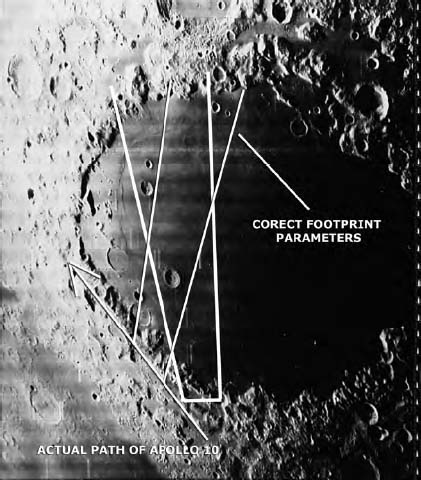Ancient Aliens on the Moon (19 page)
Read Ancient Aliens on the Moon Online
Authors: Mike Bara

Oh yeah, I did. We’ve also got a building on a mountain on the north shore of Mare Crisium and a couple of fully intact glass domes over craters there.
I first met Steve Troy in July of 1998 at a lecture given by Richard Hoagland in Phoenix. Given that I was computer savvy and Steve at the time was not, Hoagland suggested that we start working together to find and confirm evidence of lunar anomalies that might be consistent with what we had already uncovered. Steve had been quietly working to confirm Hoagland’s artificial lunar dome hypothesis for almost 2 years and I had already put up my old Lunar Anomalies web site, so it seemed like a natural fit. Steve’s approach was entirely analog, sifting through the reams of data and catalogs provided by a variety of NASA archives. Steve had been studying lunar anomalies this way since 1994, with an astronomical and geologic interest in the Moon for several years prior to that. He found numerous oddities and discrepancies in his studies, both with regard to the unnatural “geology” and the also with the photo’s themselves. I provided image enhancement and confirmation of Steve’s findings using standard digital techniques, and he likewise examined photographic negatives by eye of strange objects I had found.
One of the first frames that came up was the now familiar AS10-30-4421, the oblique image of Picard that had already been examined in some detail by Lan Fleming on the VGL website.
Fleming had focused primarily on the craters Pierce and Picard in Mare Crisium, and more specifically on the set of “arches” apparently over Picard on that image. While Steve and I had noted the arches, we were focused on another part of 4421.
The most noticeable thing right away is the very bright reflection in the upper right portion of the photo, right along the “shore” of the Sea of Crises. It is the brightest thing in the image by several orders of magnitude. That this bright reflection also caught the astronaut’s eyes is very obvious. In fact, it appears that the astronaut who was holding the 70mm Hasselblad camera took this photo to specifically to capture the bright flash on film.
AS10-30-4421 is part of a power winder sequence taken by one of the Apollo 10 astronauts as they passed just south of Mare Crisium at orbital velocity (about 3,500 Miles per Hour) with a clear view across the dark plane. Frames 4414 through 4420 were taken through one of the optically perfect windows on the spacecraft and in putting them together, you can track the progress of spacecraft as it passed by just to the south of Crisium. Essentially, the astronaut holding the camera didn’t move at all, he just kept clicking frame after frame. You can see this plainly by the changing position of Picard in each image. By frame 4419, Picard has disappeared from view off-camera right. Then on frame 4421, the astronaut suddenly turns the camera back along the path that he’d already photographed and snaps another photo. The obvious question is why, and the obvious answer is the sudden flare of light appearing along the mountain range to the right.

Anomalously bright reflection from AS10-30-4421 NASA frames AS10-30-4420 and 4421.
Obviously curious as to what had caught the astronauts’ attention to the degree that he felt compelled to turn back and get a shot of the flare, Steve made several sectional enlargements of the area and sent them to me for enhancement.

NASA frames AS10-30-4420 and 4421.
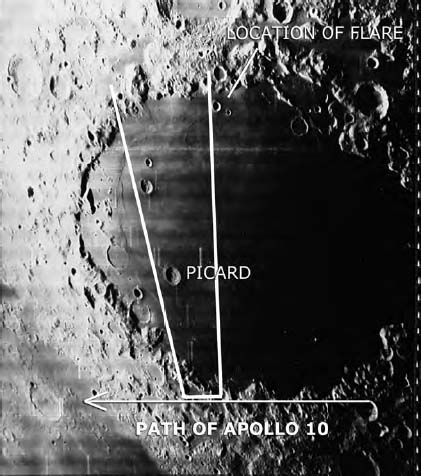
AS10-30-4421 footprint map (NASA).
The first issue was to determine where exactly the flare had come from. According to Steve (and the NASA footprint map) Apollo 10 was flying almost due west and looking almost due north across Crisium, and the edge of the photo was just west of the craters Cleomedes F and Cleomedes Fa. If this was correct, it seemed we were looking at a flare of some kind up on the mountains themselves. Even as bright as it was, it might not be anything but a very flat, reflective face of a very non-descript mountainside. Then I got my hands on the sectional.
What I saw, unmistakably to my eye at least, was a stunning edge-on photo of a clear glass dome. You can see the mountain range behind the dome and follow its contours. There also appeared to be something geometric actually
inside
the dome. It also seemed to have 2 distinct “corners” or edges, rather than blending in with the mountains behind.
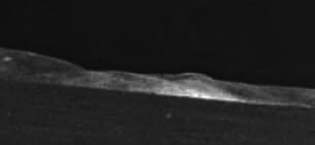
Close-up of glass domes over Cleomedes F and Cleomedes Fa.
This meant that the dome itself stands apart from the mountain chain, which implies that the dome is sitting on the Mare Crisium plane
in front
of the mountain range beyond. The other thing I immediately noticed was that the brightest area was on the right side of the dome, where there seemed to be a second dome visible behind and through the first (and larger) one.
This second dome is more opaque from the perspective of 4421 than is the main dome, and the area where it overlaps the main dome is the area of brightest albedo. This would be explained by the light sources of the two domes adding their brightness as they reflected the sunlight into the camera.
Under enhancement, the less distinct left edge of the Main Dome became more clearly defined, and this helped to confirm its location in front of the mountain chain along the North shore. There were also a series of interesting details that emerged as I got deeper into the data.
The geometric area that appeared to be inside the dome has some very interesting features, to say the least. The first was an odd bowling pin like appendage that seemed to be protruding from within the dome itself. And on the hillside above (and beyond) the dome was a tube-like, geometric formation I called the Phoenix.
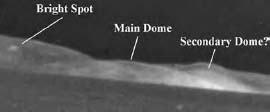
Annotated image of glass domes from AS10-30-1421.

Contrast enhanced.
It is constructed of 2 cylindrical objects interlocking with the vertical cylinder bending over to the left, giving the impression of a bird with wings outstretched in flight. I have no idea what this object might be but it stands out dramatically from the drab mountain chain it rests on and bears no resemblance to any explainable lunar geology. Its reflectivity suggests a metallic or crystalline construction. This is reinforced by the fact that such a rounded surface would not reflect this much light if were made of typical highland material.
The “Bowling Pin” is a dark bulbous object just to the right of the “Phoenix” which actually seems to protrude through the main glass dome. This appears to be an antenna of watchtower of some kind, and its middle portion is definitely obscured by the glass like material of the “Dome” itself. Note how the upper tip of the Bowling Pin is encased in the same glass like material and blots out the upper rim of the dome behind it. Again, a spike like object such as this has no place in standard lunar geology, and I am at a complete loss to explain it as anything but artificial.
Obviously, I wanted to follow this up and see if I could find another image of the area where the twin domes might be located. But looking at a number of images of Crisium yielded no results. But then it occurred to me; what if I was simply looking in the wrong place?
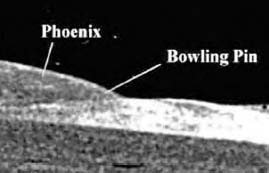
The “bowling pin.”
